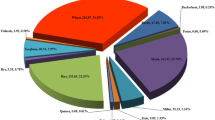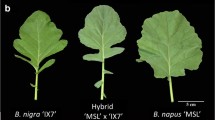Abstract
Wheat (Triticum aestivum L., 2n = 6x = 42, AABBDD) florets were emasculated and pollinated using two apomictic wheatgrass [Elymus rectisetus (Nees in Lehm.) A. Love & Connor, 2n = 6x = 42, SSYYWW] accessions, one of which produces 2n pollen. A 2n = 42 (BII) hybrid and four 2n = 63 (B III) hybrids were obtained. The spike morphology of the B II hybrid was intermediate to that of its parents. The pollen mother cells (PMCs) of this hybrid contained on average 38.361 and 1.62 II, which was consistent with its disparate genome composition (ABDSYW). Its pollen failed to stain and no BC1 progeny was obtained. The B III hybrids (reduced egg fertilized with unreduced sperm) were grasslike and had a full complement of E. rectisetus chromosomes, the synapsis of which was slightly impaired by wheat haplome and/or cytoplasm. Their PMCs contained on average 16.30 II, 25.72 I, and 1.54 multivalents (III plus IV). Pollen stainability in these hybrids was low (<1%), and when they were used as females, one 54- and 60-chromosome BC1 were obtained. A mean of 13.25 II was observed in PMCs of the 54-chromosome BC1 and pollen stainability was 10%. Pollen stainability in the 60-chromosome BC1 was only 5%. The use of 2n-pollen-producing E. rectisetus accession accelerated hybrid and BC1 formation and may accelerate the ultimate transfer of apomixis to wheat.
Similar content being viewed by others
References
Ahmad F, Comeau A (1991) Production, morphology, and cytogenetics of Triticum aestivum (L.) Thell x Elymus scabrus (R. Br.) Love intergeneric hybrids obtained by in ovulo embryo culture. Theor Appl Genet 81:833–839
Carman JG, Wang RR-C (1992) Apomixis in Triticeae. In: Elgin JH, Miksche JP (eds) Proc Apomixis Workshop. USDA-ARS, ARS-104, pp 26–29
Carman JG, Crane CF, Riera-Lizarazu O (1991) Comparative histology of cell walls during meiotic and apomeiotic megasporogenesis in two Australian Elymus species. Crop Sci 31:1527–1532
Crane CF, Carman JG (1987) Mechanisms of apomixis in Elymus rectisetus from eastern Australia and New Zealand. Am J Bot 74:477–496
Dewey DR (1984) The genomic system of classification as a guide to interspecific hybridization with the perennial Triticeae. In: Gustafson JP (ed) Gene manipulation in plant improvement. Plenum Press, New York, pp 209–279
Dong YS, Zhou RH, Xu SJ, Li LH, Cauderon Y, Wang RR-C (1992) Desirable characteristics in perennial Triticeae collected in China for wheat improvement. Hereditas 116:175–178
Gill BS, Friebe B, Endo TR (1991) Standard karyotype and nomenclature system for description of chromosome bands and structural aberrations in wheat (Triticum aestivum). Genome 34: 830–839
Green DM, Myers PZ, Reyna DL (1984) CHROMPAC III: an improved package for microcomputer-assisted analysis of karyotypes. J Hered 75:143
Hair JB (1956) Subsexual reproduction in Agropyron. Heredity 10: 129–160
Lu BR, von Bothmer R (1991) Production and cytogenetic analysis of the intergeneric hybrids between nine Elymus species and common wheat (Triticum aestivum L.). Euphytica 58:81–95
Mujeeb-Kazi A, Miranda JL (1985) Enhanced resolution of somatic chromosome constrictions as an aid to identifying intergeneric hybrids among some Triticeae. Cytologia 50:701–709
Riera-Lizarazu O, Dewey WG, Carman JG (1992) Gibberellic acid and 2,4-D treatments for wheat x barley hybridization using detached spikes. Crop Sci 32:108–114
Torabinejad J, Mueller RJ (1993a) Genome analysis of intergeneric hybrids of apomictic and sexual Australian Elymus species with wheat, barley and rye: implication for the transfer of apomixis to cereals. Theor Appl Genet 86:288–294
Torabinejad J, Mueller RJ (1993b) Genome constitution of the Australian hexaploid grass Elymus scabrus (Poaceae: Triticeae). Genome 36:147–151
Torabinejad J, Carman JG, Crane CF (1987) Morphology and genome analysis of interspecific hybrids of Elymus scabrus. Genome 29:150–155
Wang RR-C (1989) Intergeneric hybrids involving perennial Triticeae. Genetics (Life Sci Adv) 8:57–64
Wang RR-C, Marburger JE, Hu C-J (1991) Tissue culture facilitated production of aneupoly-haploid Thinopyrum ponticum and amphidiploids of Hordeum violaceum x H. bogdanii and their uses in phylogenetic studies. Theor Appl Genet 81:151–156
Wang RR-C, Liu Z-W, Carman JG (1993) The introduction and expression of apomixis in hybrids of wheat and Elymus rectisetus. In: Chen S-Y (ed) Proc 8th Int Wheat Genet Symp. Beijing, China (in press).
Author information
Authors and Affiliations
Additional information
Communicated by G. E. Hart
Rights and permissions
About this article
Cite this article
Liu, Z.W., Wang, R.R.C. & Carman, J.G. Hybrids and backcross progenies between wheat (Triticum aestivum L.) and apomictic Australian wheatgrass [Elymus rectisetus (Nees in Lehm.) A. Löve & Connor]: karyotypic and genomic analyses. Theoret. Appl. Genetics 89, 599–605 (1994). https://doi.org/10.1007/BF00222454
Received:
Accepted:
Issue Date:
DOI: https://doi.org/10.1007/BF00222454




